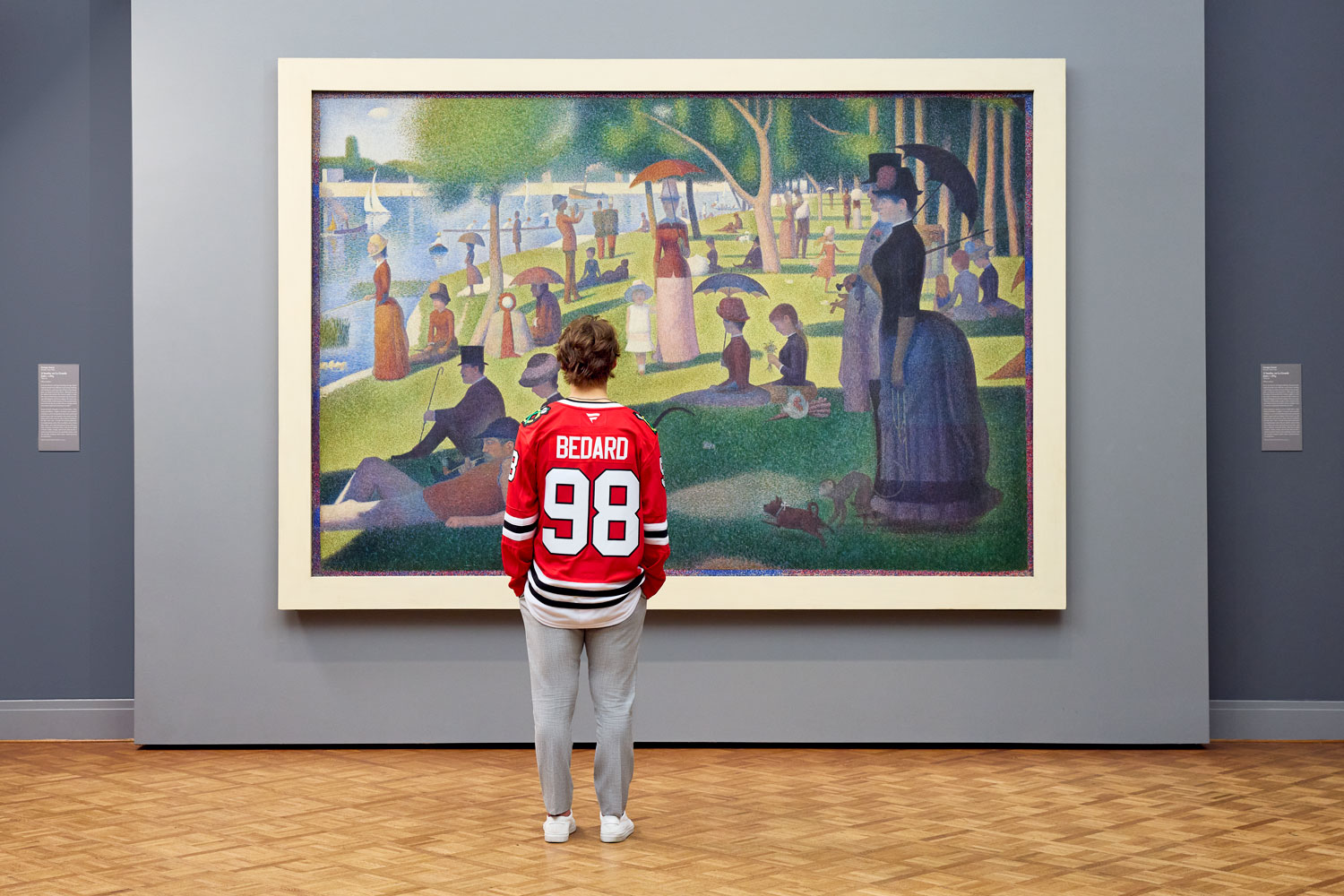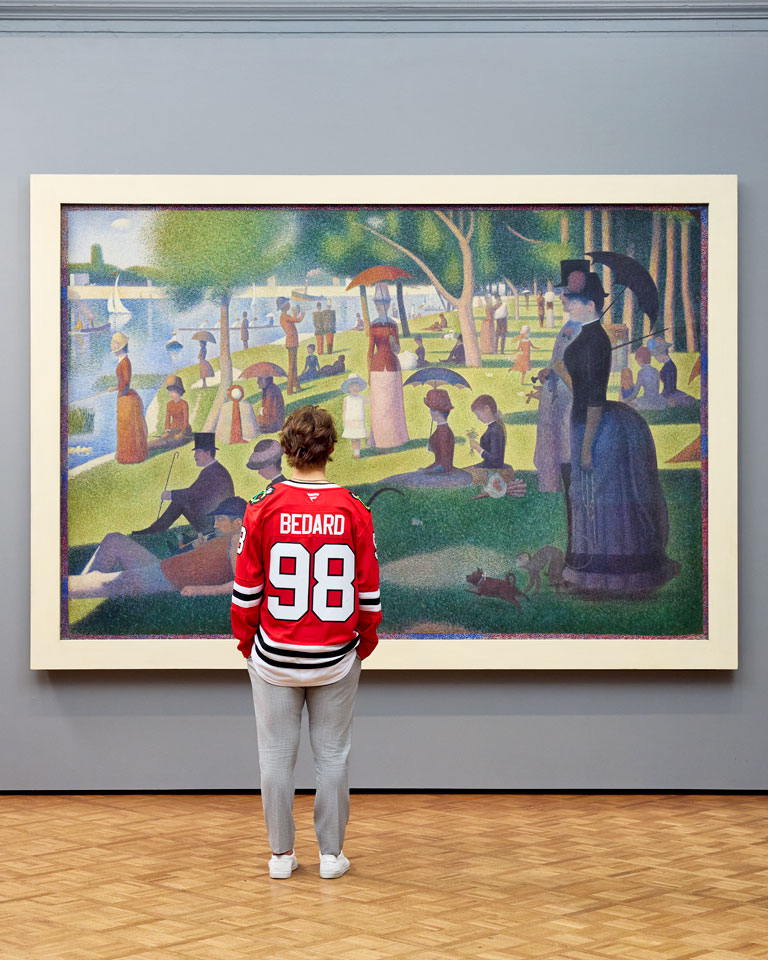The brightest young star in the National Hockey League sinks into a black leather club chair in the corner of a Blackhawks meeting room. The season opener is a little less than two weeks away, and his team has just finished a spirited morning practice and mandatory meeting. He clutches a water bottle, beads of condensation dripping down its sides, and lets out a huge sigh. He doesn’t want to be here.
It isn’t that Connor Bedard is cocky, arrogant, or rude. Quite the opposite. Even late on a day when a Blackhawks staffer cautions that Bedard might be a bit, well, cranky, the 19-year-old comes off polite, polished, and respectful beyond his years. He makes eye contact when answering questions and uses “please” and “thank you.” It’s just that there are other places he’d rather be. Like at the gym. Or on a sheet of ice. Or in the Blackhawks shooting room, perfecting his craft.
“I want to be able to say I found out how good I could possibly be,” Bedard says. “However good that is, nobody knows. But I want to find out.”
For now he’s stuck in this cushy black chair, his tree-trunk-size legs bouncing up and down like pistons as he attempts a task he’s still learning to navigate: talking about himself. There’s been a lot of that over the last year and a half, since the Blackhawks won the NHL’s draft lottery in May 2023 and used the No. 1 overall pick to select a generational talent many believe can change the course of the team’s future. The comps thrown around in hockey circles are the game’s royalty. Connor McDavid. Sidney Crosby. Mario Lemieux. And yes, perhaps even that guy named Gretzky. It was the Great One, after all, who witnessed a jaw-dropping Bedard goal in person last season and confessed, during a midgame TV interview, “I couldn’t do what he did tonight.”
They are daunting expectations for anyone, let alone a teenage millionaire living on his own for the first time 2,000 miles from home. Yet last season, as the youngest player in the NHL, he led the Blackhawks in goals (22), assists (39), and points (61) despite missing 14 games with a broken jaw. His 0.90 points per game average was the seventh-best mark of all time for an 18-year-old rookie — and the second best this century, behind only Crosby. He was the youngest player ever selected for the NHL All-Star Game and was the easy choice for the Calder Trophy, awarded to the top rookie.
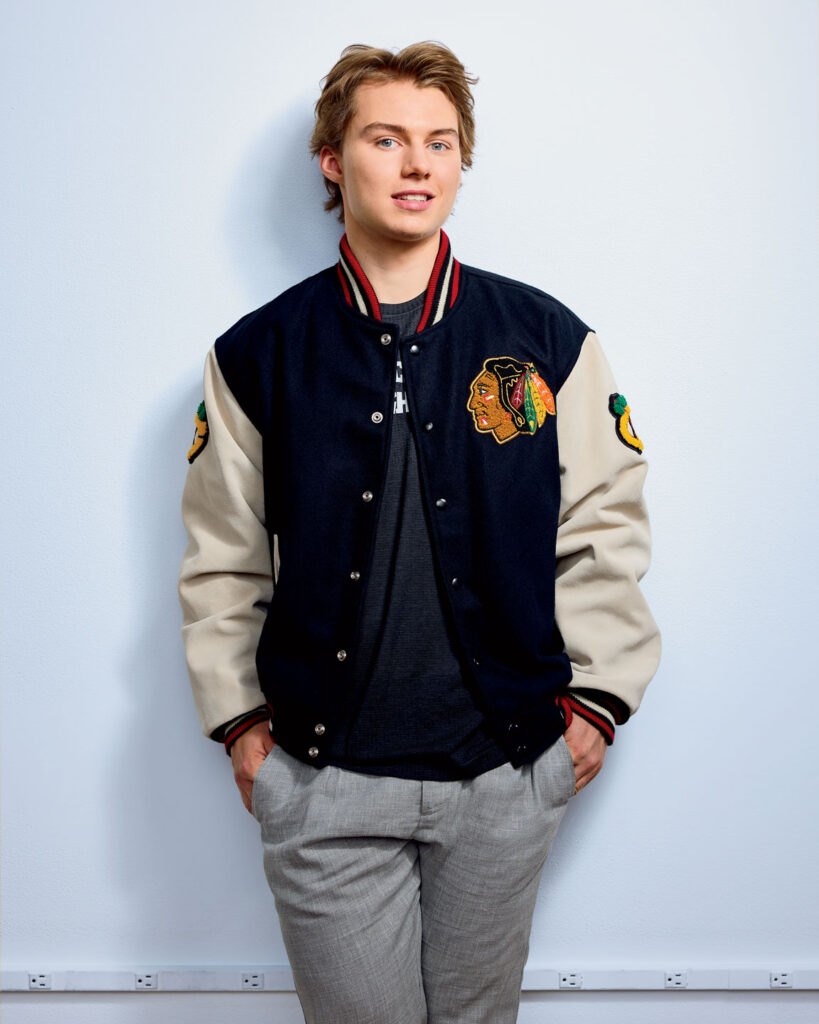
Year 2 has brought with it a greater sense of familiarity and a few less flashbulbs. But it still feels like so much is at stake: The rebuilding of one of the NHL’s iconic teams, an Original Six franchise that has fallen on hard times since the success of the 2010s. The league’s ongoing search for its next young superstar. And for Bedard himself, the singular goal that has driven him for as long as he can remember — a ceaseless quest to achieve his full potential.
Comprehend that fact, and Bedard’s obsessive behaviors begin to make sense. Eating squeaky clean. Staying on the ice long after his teammates. Hanging around the practice facility later than his coaches and the Blackhawks’ management. “We tried to tell him he can go home once in a while,” says general manager Kyle Davidson, “and he just said, ‘Why wouldn’t I want to be here?’ ”
This is why Connor Bedard would rather not be sitting in that black chair right now, inside the same Blackhawks meeting room where he signed his first NHL contract, last July on his 18th birthday. This talking-about-himself stuff? It isn’t hockey. It doesn’t help him get to the place he so desperately wants to go. “I want to be able to say I found out how good I could possibly be,” he says. “However good that is, nobody knows. But I want to find out.”
Last September, in his first week in Chicago, Bedard meandered the aisles of a downtown Whole Foods, executing for the first time on his own one of the most adult tasks in life: grocery shopping. There were no attempts to hide, no hoodie pulled over his head or mirrored sunglasses shielding his eyes. Even now, Bedard often still blends into the background in Chicago, far more than he does back home in Canada, where he’s hockey’s version of a teenage heartthrob.
He felt a cart poke him in the small of the back. His body stiffened, but he refused to turn around. He kept walking. The cart rammed him again. “I’m just thinking, Who the fuck is this?” Bedard recalls. Annoyed, he stepped to the side and spun around. There stood Luke Richardson, the Blackhawks’ head coach.
“It’s the game within the game,” says teammate Nick Foligno. “When you are the best player, you are being watched by your own team and targeted by the other team.”
“His eyes were huge,” Richardson says with a smile. “You could tell he was relieved it was me. I was just having a little fun, helping him feel like part of the team.”
A few weeks later in Pittsburgh, Bedard slid toward the centerline for the first face-off of his NHL career. A few feet away and gradually inching closer was Crosby, a boyhood hero of Bedard’s. Eighteen years earlier, it was Crosby who entered the league as the überhyped No. 1 overall pick. Crosby delivered, blossoming into a 10-time All-Star, two-time league MVP, and three-time Stanley Cup champion.
“Sid,” the referee, Kelly Suther-land, said, “welcome back for another season. Connor, welcome to the NHL, man.”
“Good luck,” Crosby quietly said to the rookie.
“Thank you,” Bedard replied to Crosby. “Thank you,” he repeated to Sutherland.
The puck dropped. Crosby won the face-off, but the Blackhawks took the game, with Bedard earning his first NHL point on a second-period assist in a 4–2 win. The debut generated more than 300 million impressions on social media, the Blackhawks say, helping make them the league’s most followed team on X. Call it the Bedard effect.
The Hawks had already received special permission from the league to circumvent a rule that prohibits a team from selling a player’s jersey until they’ve appeared in a regular-season game. Similar exceptions were made for Crosby and McDavid. And by the end of the season, Bedard had the best-selling jersey in the NHL, and the Blackhawks enjoyed a boost in attendance and television ratings. “The attention and visibility is unlike anything we’ve ever seen,” Davidson says.
When Bedard has the puck, you don’t want to look away. The rest of the NHL marvels at his stickhandling, puck skills, and blistering shot, a take-from-any-angle howitzer Richardson considers among the best 5 percent in the league. Beyond the on-ice skills, Davidson says, is an “elite” hockey sense that gives Bedard the ability to read the game and anticipate what’s about to happen.
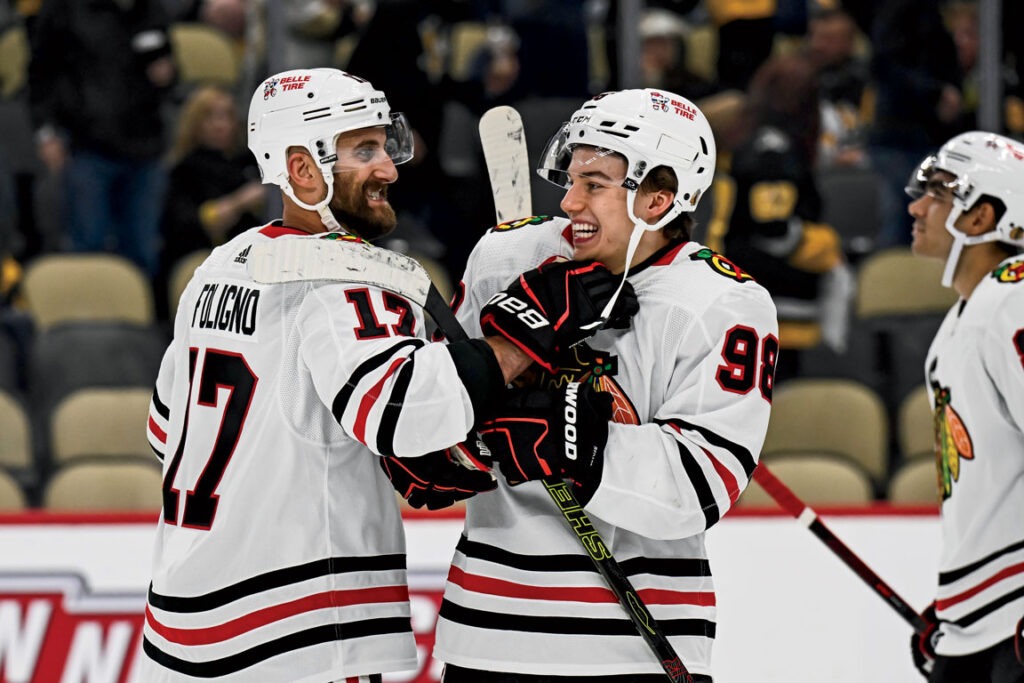
That total package offers the Blackhawks the leverage to sell the ingredient fans crave most: hope. The franchise hasn’t won a playoff game since 2015, when it beat the Lightning to win the Stanley Cup. In the wake of the Patrick Kane and Jonathan Toews era, the Blackhawks opted for a down-to-the-studs rebuild, accepting a few pitiful seasons in exchange for a restocked pool of young talent. The approach looked genius when the team finished with the third-worst record in the 2022–23 season and won the chance to select Bedard. Now, after four straight losing seasons, the Blackhawks are seen by many NHL evaluators as having the best collection of young talent in the league. The team’s reinvention just needs time.
Last year, Chicago finished with the league’s second-worst record. There were far more nights like the fifth game of the season, a humbling 4–0 loss to the Colorado Avalanche, than the opener in Pittsburgh. In Denver, Bedard experienced a rare feeling on the ice: helplessness. No matter what he tried, it seemed like he couldn’t make a difference. By the time the game ended, he would log nearly 20 minutes with nothing to show for it. No shots. No hits. No blocks. Nothing. “It was so awful,” Bedard says. “It felt like I didn’t touch the puck the whole game. I kept thinking, This is so hard, these guys are so good. It was almost comical.”
Learning how to cope with failure while not accepting it, Bedard admits, has been a process. Chicago infused this year’s team with more veteran talent, signing seven players 29 or older to help Bedard as he grows. But he’s still learning to better channel his frustration when things don’t go his way. In this year’s season-opening loss to Utah, he slammed his stick during an exasperating first period. “You have a couple shifts, you don’t get a chance, you get pissed off,” he says. “That’s something I can work on. It’s a hard league.”
Even in practice, he can show his frustration. Richardson says Bedard will lose a face-off, get irritated, then yell at an opponent or slash him with his stick. “It’s the game within the game,” Blackhawks captain Nick Foligno explains. “You need your emotions to play hockey, but you can’t put your energy in places it doesn’t belong. When you are the best player you are being watched by your own team and targeted by the other team. It’s the hardest balance to find.”
When he does, the results have been staggering. Like two months into his rookie season, when Bedard took over back-to-back road games in Florida. Against the Lightning, he swiped a puck from former league MVP Nikita Kucherov and nudged it ahead to Foligno, who tapped it back to Bedard for a nifty backhanded goal as part of a two-goal, two-assist night, helping Bedard become the youngest player to record a four-point game since 1944. For an encore three nights later against the Panthers, Bedard poked a puck loose from Kevin Stenlund, tapped it off the end of his right skate, and with one quick flick of the wrist beat All-Star goaltender Sergei Bobrovsky from an absurd angle on the side, nearly on the same plane as the goal, for one of his two scores. Two nights, six points.
“He was electric,” Richardson says. “That’s when it was like, OK, he’s doing these things night after night. That’s special.”
Before this summer, the earliest traces of Bedard’s passion for hockey could be found in the scratches and gouges in the hardwood floor of his parents’ home in North Vancouver, British Columbia. That’s where this obsession began, with Bedard Rollerblading and stickhandling all around the house. But with their son now in the NHL, the Bedards refinished their floors a few months back and, in so doing, sanded over a small piece of hockey history.
Jon Calvano coached the Vancouver Vipers, a youth team Bedard played for in those early days, and he still remembers when he and his team manager asked what jersey numbers their players wanted for the upcoming season. The answers were typical for hockey-crazed Canadian boys back then: 87 for Crosby, 71 for Evgeni Malkin, 8 for Alex Ovechkin. Then there was Bedard, just 5 years old, asking for 98. At the time, 98 had been worn by only one player in NHL history. So Calvano asked: “Who’s 98?”
“I’m 98,” Bedard replied.
“The manager and I just sort of looked at each other like, ‘Wow.’ Now you see every young kid with 98,” Calvano says. “Makes me proud.”
Bedard grew up about a 10-minute bike ride from the North Shore Winter Club, with access to multiple ice rinks. It was his home away from home, where he constantly worked on his shot, stickhandling, and attacking the net from different angles. Calvano remembers the day Bedard scored eight points to lead his under-14 team to a draining 13–12 Sunday afternoon win. After the game, most everyone headed home to watch football, Calvano included. But later that night, when the coach popped by North Shore, there was Bedard, by himself on the ice.
“Some kids like to go shoot hoops or play on the monkey bars,” Calvano says. “Connor likes skating.”
There’s a story that has become part of Bedard lore: He once tried to talk his way out of a family vacation to Hawaii because he wouldn’t be able to practice hockey. The family reached a compromise: He could bring his in-line skates and his stick with him.
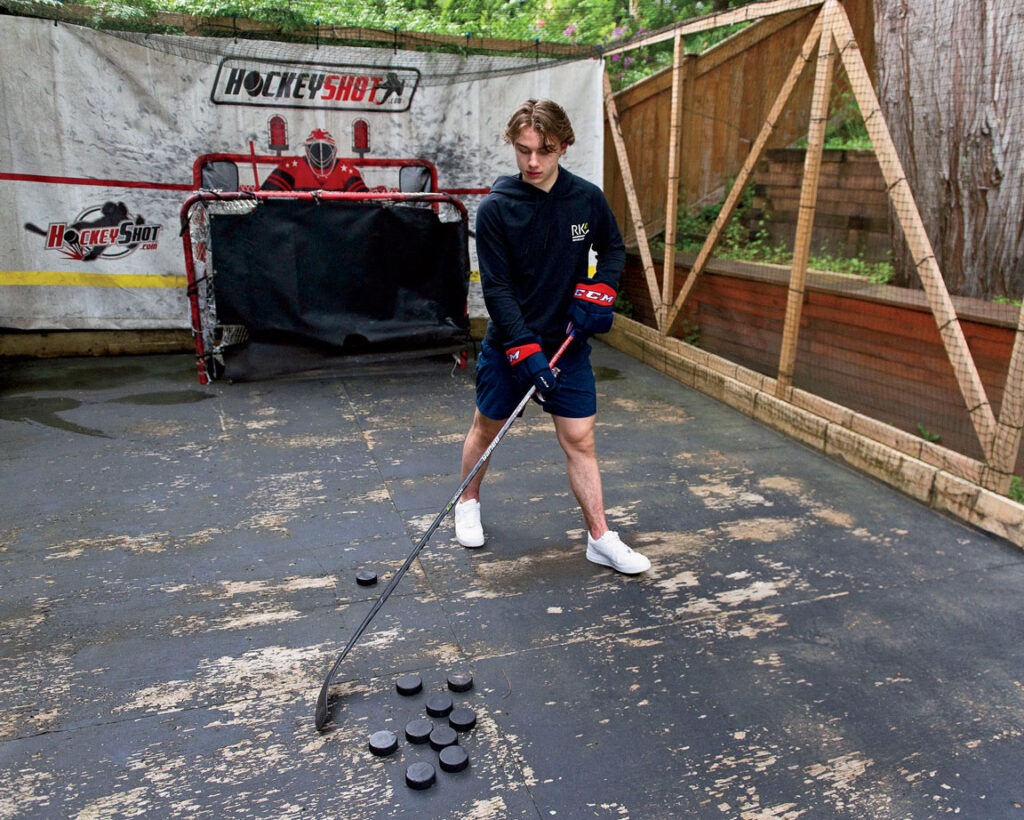
The neighbors surely appreciated the quiet. Bedard had a reputation for relentlessly shooting pucks in front of his house. Mostly they ended up in the back of the net, but sometimes they found a window. After one such incident, a neighbor built a small shooting gallery in Bedard’s backyard, complete with a plywood platform and a large wooden frame with netting surrounding the goal on three sides. It’s still there today, thousands of shots later. Bedard even used the setup while he was home this summer during his first NHL off-season. “I can’t let my parents sell the house,” he says.
Bedard also worked on conditioning, speed, and power while he enjoyed the comforts of home. Unlike a returning college freshman struggling to reacclimate to their parents’ rules, Bedard found sleeping in his old bed a dream: “I’d get up from working out or skating that morning, and breakfast would be ready. I didn’t have to pay rent or anything. It was pretty nice.” Then he adds: “I love spending time with my family.”
It’s a throwaway line most anyone would say. But with Bedard you actually believe it. He can’t say enough about his older sister, Madisen, a mentor he describes as “unselfish” and “responsible.” She helps her brother with emails and other tedious tasks. Connor’s father, Tom, has spent more than 25 years working in forestry, waking up to a middle-of-the-night alarm and thermos of hot coffee before heading deep into the forests of British Columbia for the treacherous task of chopping down 100-foot trees. “A true Johnny Canuck,” Calvano says, a reference to the Canadian lumberjack cartoon. Afterward, Tom would race home to watch Madisen’s gymnastics training or Connor’s hockey practice. Connor’s mother, Melanie, kept it all together at home for the family, who often hosted international students.
When he’s alone, Bedard ends each day calling home to say good night to his parents. “Dad and I talk about the game,” he says. “And Mom always wants to know how I’m feeling.”
When Bedard was 15, Melanie moved with her son to Regina, where he played for the Pats in Canada’s Western Hockey League. He was the first player in the junior league’s history to be granted exceptional status, allowing him to play a year early. When the COVID-19 pandemic delayed Bedard’s WHL debut, he played in Sweden, and Madisen tagged along.
After Chicago drafted Bedard, his family and agents and the Blackhawks contemplated having him live with a teammate, much like Crosby lived with Lemieux the first five seasons of his career. But they ultimately decided to allow Bedard to live on his own in the same secure downtown high-rise as Richardson and a few Blackhawks teammates. Last season, Bedard says, someone from his family was in town about half the time. And when he’s alone, Bedard ends each day calling home to say good night to his parents. “Dad and I talk about the game,” he says. “And Mom always wants to know how I’m feeling.”
A year into the experiment, Bedard admits living on his own has been good for him. He grew up dependent, leaning on his parents and sister for most everything. Now he does his own laundry and cooks basic health-conscious meals, like grilled chicken breasts, steamed vegetables, and rice, with his mom’s assistance via FaceTime. “There’s no sick recipes or anything like that,” he says. “She just helps me make sure it’s going to be good.”
Three-quarters of the way through Bedard’s rookie season, he sat on the Blackhawks bench during a home game against Anaheim when a clip of Queen frontman Freddie Mercury appeared on the United Center jumbotron. It was the famous scene from Live Aid in 1985 when Mercury urges the Wembley Stadium crowd to repeat after him: “Aaaaaay-o.” The clip has since become an amp-up-the-crowd arena staple. Foligno, who was stunned throughout the season at the canyon-size holes in Bedard’s pop culture knowledge, asked the teenager if he knew who the singer was.
“He threw out the most ridiculous things,” Foligno, now 37, recalls. “Eddie Vedder because I had just taught him Pearl Jam. Then John Lennon. He couldn’t have been any further from the right guy.”
A microphone during the television broadcast caught Foligno giving Bedard a hard time. “There’s so much to teach you,” he said on the bench. “I don’t have enough contract time. I’m going to have to stay in Chicago for like five years after I retire.”
Bedard laughs about it now: “They want to talk about some artist from the 1950s or something that I don’t know and then rip me for being so young.”
It was the latest in the back-and-forth banter between the rookie who can’t yet grow a beard and the 17-year NHL veteran who can no longer grow hair on the top of his head. Like the day toward the end of training camp this year when Foligno and Bedard both scored in two-on-one drills, but the 50 or so fans in attendance cheered only for Bedard. “I guess you’re on the away team today,” Bedard chirped.
Foligno first reached out to Bedard shortly after the ’23 draft. They talked about family. Summer vacation. Before hanging up, Bedard asked his new teammate a question. The year before, Foligno was part of a Boston team that set the NHL record for points in a season. Bedard wanted to know what made that team special. “Here we are, it’s July. I’m not thinking about any of that, and he wants to figure out what he can do to be the best,” Foligno says. “I was really impressed.”
It was an opportunity for one of the many lessons, woven among banter, that Foligno, Richardson, and other Blackhawks have taken pride in teaching the teenager. How to manage the grind of an 82-game schedule. How to keep your cool when things don’t go your way on the ice. When to try a high-risk, high-reward maneuver rather than playing fundamentally disciplined. And how crucial it is to try and escape hockey when you head home each day.
That one Bedard is working on. Because in his eyes, there really isn’t much to escape to. It’s not just that he doesn’t know Queen or Pearl Jam — how many 19-year-olds do? — it’s that there isn’t an interest in much beyond hockey and other sports.
Music?
“I don’t really listen to a whole lot. I’m pretty chill with whatever.”
TV shows?
“I really only watch shows when I’m on a plane.”
Like?
“I’m watching that NBA documentary on Netflix right now.”
Bedard doesn’t even remember how he celebrated his 19th birthday.
“I know I hung out with my family. Maybe we got dinner or something? I don’t even remember what we had,” he says. “I have a terrible memory. With hockey it’s a lot better. But with other stuff it’s rough.”
“He’s a hockey robot,” Foligno explains. “We’re all hockey geeks and hockey nerds at heart. But he is more so than most. It’s wonderful to be so driven. But he still needs to know his shit.”
When Bedard returns to his apartment after a game, the routine is simple. Make some dinner, plop himself on the couch, and watch a hockey game. There are no wild parties, loud music, or even late-night video gaming. If he isn’t watching sports, he’s thumbing through TikTok and YouTube — in that way, he’s a typical teenager — and FaceTiming with his friends and former teammates from Regina and back home. He doesn’t go out much. He hasn’t even been to a Bulls game, even though they play in the same building as the Blackhawks. “I live a pretty basic life,” he says.
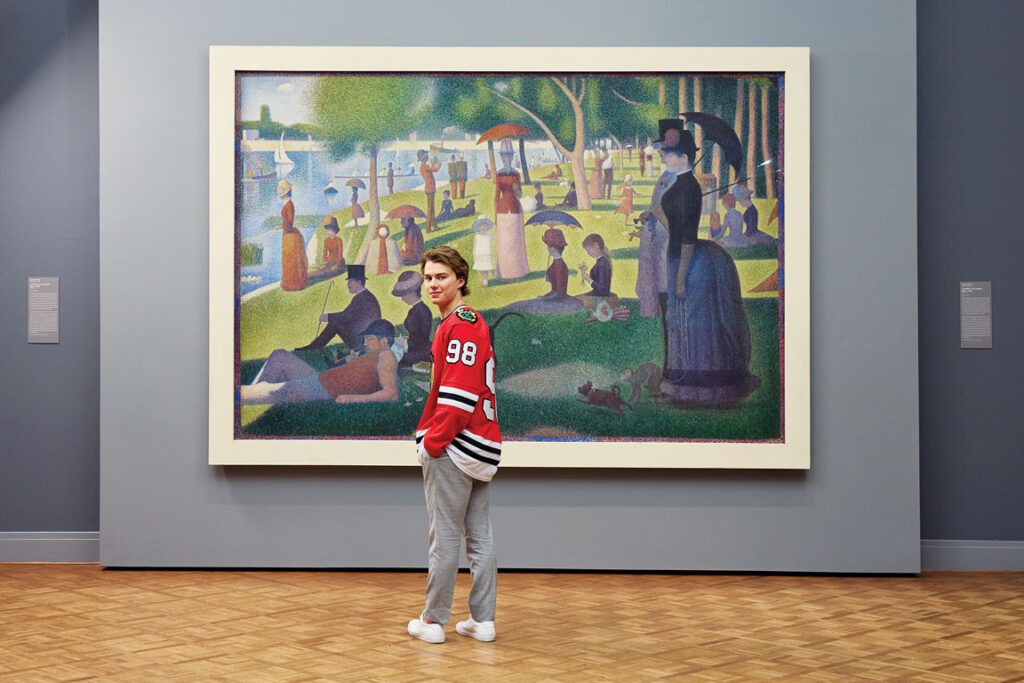
Just before the midway point of his rookie season, on January 5 in New Jersey, Bedard was carrying the puck across the blue line, weaving between defensemen, when the Devils’ Brendan Smith introduced his right shoulder to Bedard’s face. The hit lifted Bedard off the ice and spun him around like a propeller. He immediately reached for his jaw, then stood up, skated off the ice, and headed straight for the Blackhawks dressing room.
Taylor Raddysh, who was out that night with an injury, went to check on his teammate. “I knew right away as soon as I saw him,” says the 26-year-old forward. “His face was massive. You could tell he was in a lot of pain.”
The two had built a friendship over the course of the season. They lived in the same building and carpooled to practice and the airport, until Raddysh grew tired of Bedard’s first-one-to-get-there, last-one-to-leave, let’s-live-at-the-practice-facility mentality. Still, they ate together on the road. “I would always joke with him that I was going to take him to McDonald’s,” Raddysh says. “And he would freak out and be like, ‘No way. Absolutely no way.’ ”
On the flight home from New Jersey the night Bedard was hit, the Blackhawks’ training staff asked Raddysh if Bedard could stay with him that night. Raddysh’s wife had family in town, so the couple and their labradoodle set up camp in Bedard’s guest room. “I told them I was fine — they didn’t need to stay,” Bedard says. “But they came up. I appreciated that. His wife was on me about putting the ice on and everything, acting like a mom.”
Melanie Bedard arrived the next day to be with her son. But that first night, it was the Raddyshes staying up past 2 a.m. with Bedard. “Just trying to be there for him,” explains Raddysh, who now plays for the Washington Capitals. “He was having trouble sleeping with the pain.”
Three days later, Bedard underwent surgery to repair a broken jaw. Doctors estimated he would miss six to eight weeks. Bedard wasn’t having it. He persuaded team trainers to let him skate one week after surgery. Unable to eat solid foods, he drank soups and smoothies. And kept the pressure on Davidson, the GM, to let him return.
“It was frustrating,” Bedard says. “I would feel totally normal for a lot of it and wonder, Why am I not playing? I was a little impatient.”
Bedard pestered Blackhawks personnel for multiple CT scans and regular doctor appointments in an effort to get cleared sooner. After all, it was a jaw injury — not a knee problem that would keep him from skating, or a shoulder knock that would bother him every time he passed or took a shot. One day shy of the six-week mark, Bedard returned to action.
“There is a patience factor when you love the game as much as he does that isn’t always there,” Davidson says. “But 10 times out of 10, you want players who are going to push you to let them play versus guys you are pushing to play. With Connor, you’ve got to pull the reins sometimes.”
At a morning skate last season during a three-games-in-four-nights run, Richardson told Bedard to rest and stay off the ice. When Bedard began poking around the locker room, Richardson, sensing the rookie might try to practice, removed Bedard’s Sherwood hockey sticks from the shooting rack and hid them in his office. Because of Bedard’s endorsement deal with the brand, the coach knew Bedard likely wouldn’t go on the ice with a different stick for fear of being photographed with it.
“I just wanted to make a point,” Richardson says. “I know we had fun with him that day, but hopefully it translated. There’s a reason for it. We aren’t just telling people what to do.”
Bedard now finds it amusing. “It was worse in juniors,” he says. “They’d just take all my gear.”
Ask those around Bedard about the biggest difference between his rookie year and now, and one word continues to pop up: comfortable. He began his second season still the third-youngest player in the league. But gone is the laundry list of unknowns. New city, new coach, and new teammates. The toil of an 82-game NHL season. Living on his own. Managing his rest. Bedard knows he’s the face of the franchise. He gets that he’s the one the media want to talk to in every road city. He’s the one ESPN asks to wear a mic during national broadcasts. “He just seems more at ease,” says Calvano, his youth team coach.
Bedard often stays at Calvano’s place on the outskirts of Toronto when he’s training there during the summer. Before his rookie year, Bedard was there for a month. This summer it was about two weeks. Calvano sensed a difference. Whereas last year Bedard skated for two hours before an eight-hour commercial shoot, this year Calvano watched Bedard better manage his workload in that ongoing pursuit of balance. “I felt like he did less,” Calvano says. “Not a normal person’s less, but less for him.”
It would seem close to impossible for Bedard to put together an MVP season in his second year. But it would also seem foolish to use the word “impossible” in the same sentence as “Connor Bedard.”
Part of Bedard’s training this past off-season included skating with McDavid, the NHL’s previous young phenom, who entered the league in 2015. After scoring 48 points in 45 games as a 19-year-old rookie, McDavid exploded his second year, tallying 100 points while winning his first Hart Trophy, awarded to the league’s most valuable player. On one hand, it would seem close to impossible for Bedard to put together an MVP season in his second year. (Crosby and Gretzky are the only teenage MVPs in North American major sports history.) But it would also seem foolish to use the word “impossible” in the same sentence as “Connor Bedard.”
After all, there was Bedard in the third game this season, outplaying McDavid in a 5–2 Chicago win over Edmonton, the defending Western Conference champions. In the second period, Bedard poked away a puck at one end, took a pass from Teuvo Teravainen at the other, and then artfully glided to center ice before firing one of his did-you-see-that rockets past the helpless Oilers goalie. He added two assists that night and was voted the game’s No. 1 star. It was absurdly early, but the five points in Chicago’s first three games put him on pace for 136 for the season. Only three times since 2000 has an NHL player finished a season with more. (After seven games, Bedard had come down to earth, with a still-impressive seven points.)
Impossible?
“There is stuff that is impossible and stuff that is hard to do,” Bedard says. “That’s not impossible. It’s a lot of points. But you know …” He pauses to consider the feasibility. “I guess it’s not impossible.”



